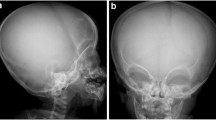Abstract
Purpose
Achondroplasia is a skeletal dysplasia with diminished growth of the skull base secondary to defective enchondral bone formation. This leads to narrowing of the foramen magnum and jugular foramina, which further leads to ventricular dilatation and prominence of the emissary veins. The primary goal of our study was to determine a correlation between the degree of ventricular dilatation, jugular foramina and foramen magnum narrowing, as well as emissary vein enlargement.
Methods
Conventional T2-weighted MR images were evaluated for surface area of the foramen magnum and jugular foramina, ventricular dilatation, and emissary veins enlargement in 16 achondroplasia patients and 16 age-matched controls. Ratios were calculated for the individual parameters using median values from age-matched control groups to avoid age as a confounder.
Results
Compared to age-matched controls, in children with achondroplasia, the surface area of the foramen magnum (median 0.50 cm2, range 0.23–1.37 cm2 vs. 3.14 cm2, 1.83–6.68 cm2, p < 0.001) and jugular foramina (median 0.02 cm2, range 0–0.10 cm2 vs. 0.21 cm2, 0.03–0.61 cm2, p < 0.001) were smaller, whereas ventricular dilatation (0.28, 0.24–0.4 vs. 0.26, 0.21–0.28, p < 0.001) and enlargement of emissary veins (6, 0–11 vs. 0, p < 0.001) were higher. Amongst the patients, Spearman correlation and multiple regression analysis did not reveal correlation for severity between the individual parameters.
Conclusions
Our study suggests that in children with achondroplasia, (1) the variation in ventricular dilatation may be related to an unquantifiable interdependent relationship of emissary vein enlargement, venous channel narrowing, and foramen magnum compression and (2) stable ventricular size facilitated by interdependent factors likely obviates the need for ventricular shunt placement.


Similar content being viewed by others
References
Horton WA, Hall JG, Hecht JT (2007) Achondroplasia. Lancet 370:162–172
Gordon N (2000) The neurological complications of achondroplasia. Brain Dev 22:3–7
Yamada H, Nakamura S, Tajima M, Kageyama N (1981) Neurological manifestations of pediatric achondroplasia. J Neurosurg 54:49–57
Bruhl K, Stoeter P, Wietek B, Schwarz M, Humpl T, Schumacher R, Spranger J (2001) Cerebral spinal fluid flow, venous drainage and spinal cord compression in achondroplastic children: impact of magnetic resonance findings for decompressive surgery at the cranio-cervical junction. Eur J Pediatr 160:10–20
Sainte-Rose C, LaCombe J, Pierre-Kahn A, Renier D, Hirsch JF (1984) Intracranial venous sinus hypertension: cause or consequence of hydrocephalus in infants? J Neurosurg 60:727–736
Steinbok P, Hall J, Flodmark O (1989) Hydrocephalus in achondroplasia: the possible role of intracranial venous hypertension. J Neurosurg 71:42–48
Moritani T, Aihara T, Oguma E, Makiyama Y, Nishimoto H, Smoker WR, Sato Y (2006) Magnetic resonance venography of achondroplasia: correlation of venous narrowing at the jugular foramen with hydrocephalus. Clin Imaging 30:195–200
Wright MJ, Irving MD (2012) Clinical management of achondroplasia. Arch Dis Child 97:129–134
Aryanpur J, Hurko O, Francomano C, Wang H, Carson B (1990) Craniocervical decompression for cervicomedullary compression in pediatric patients with achondroplasia. J Neurosurg 73:375–382
DiMario FJ, Ramsby GR, Burieson JA, Greensheilds IR (1995) Brain morphometry analysis in achondroplasia. Neurology 45:519–524
Pauli RM, Horton VK, Glinski LP, Reiser CA (1995) Prospective assessment of risks for cervicomedullary-junction compression in infants with achondroplasia. Am J Hum Genet 56:732–744
Rekate HL (2008) The definition and classification of hydrocephalus: a personal recommendation to stimulate debate. Cerebrospinal Fluid Res 5:2
Pierre-Kahn A, Hirsch JF, Renier D, Metzger J, Maroteaux P (1980) Hydrocephalus and achondroplasia. A study of 25 observations. Childs Brain 7:205–219
Friedman WA, Mickle JP (1980) Hydrocephalus in achondroplasia: a possible mechanism. Neurosurgery 7:150–153
Lundar T, Bakke SJ, Nornes H (1990) Hydrocephalus in an achondroplastic child treated by venous decompression at the jugular foramen. Case Report J Neurosurg 73:138–140
Swift D, Nagy L, Robertson B (2012) Endoscopic third ventriculostomy in hydrocephalus associated with achondroplasia. J Neurosurg Pediatr 9:73–81
Kao SC, Waziri MH, Smith WL, Sato Y, Yuh WT, Franken EA Jr (1989) MR imaging of the craniovertebral junction, cranium, and brain in children with achondroplasia. AJR Am J Roentgenol 153:565–569
Erdincler P, Dashti R, Kaynar MY, Canbaz B, Ciplak N, Kuday C (1997) Hydrocephalus and chronically increased intracranial pressure in achondroplasia. Childs Nerv Syst 13:345–348
Rollins N, Booth T, Shapiro K (2000) The use of gated cine phase contrast and MR venography in achondroplasia. Childs Nerv Syst 16:569–575, discussion 575-567
Hunter AG, Bankier A, Rogers JG, Sillence D, Scott CI Jr (1998) Medical complications of achondroplasia: a multicentre patient review. J Med Genet 35:705–712
King JA, Vachhrajani S, Drake JM, Rutka JT (2009) Neurosurgical implications of achondroplasia. J Neurosurg Pediatr 4:297–306
Hoover-Fong JE, McGready J, Schulze KJ, Barnes H, Scott CI (2007) Weight for age charts for children with achondroplasia. Am J Med Genet A 143A:2227–2235
Grant/financial support
Benedikt Hergan’s work on the study was partially supported by a scholarship grant from the Medical University of Graz, Austria. Kathryn Carson’s work on the study was supported by the National Center for Research Resources and the National Center for Advancing Translational Sciences (NCATS) of the National Institutes of Health through Grant Number 1UL1TR001079.
Authors’ contributions
TB, TAGMH, and AP conceptualized and designed the study; AP generally supervised the study; TB, GO, BH, and AP participated in the acquisition of data; TB, GO, and BH analyzed conventional neuroimaging data; TB, GO, BH, TAGMH, and AP interpreted the results; KAC performed statistical analysis; TB drafted the manuscript; All the co-authors critically revised the manuscript for intellectual content and read and approved the final manuscript.
Conflict of interest
All coauthors do not report conflicts of interest.
Author information
Authors and Affiliations
Corresponding author
Rights and permissions
About this article
Cite this article
Bosemani, T., Orman, G., Hergan, B. et al. Achondroplasia in children: correlation of ventriculomegaly, size of foramen magnum and jugular foramina, and emissary vein enlargement. Childs Nerv Syst 31, 129–133 (2015). https://doi.org/10.1007/s00381-014-2559-4
Received:
Accepted:
Published:
Issue Date:
DOI: https://doi.org/10.1007/s00381-014-2559-4




